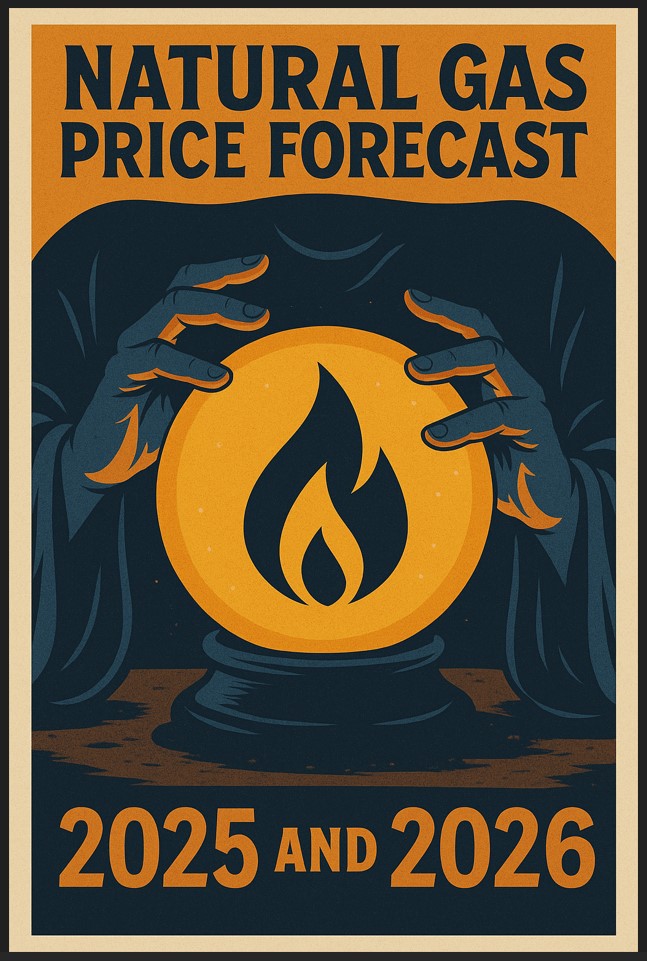2025 & 2026 Natural Gas Forecast

Natural Gas Price Outlook: 2025 & 2026 Projections and What to Expect
By WattForecast | May 2025
Natural gas plays a foundational role in the U.S. energy economy—powering commercial heating systems, industrial manufacturing, and over a third of electricity generation. As we move through 2025 and into 2026, natural gas prices are trending upward, with growing global demand and tightening domestic supply setting the stage for sustained volatility.
This article outlines projected price levels and the critical factors shaping the future of natural gas markets.
📊 Natural Gas Price Projections
| Year | Avg. Henry Hub Spot Price | Year-over-Year Change |
|---|---|---|
| 2024 | $3.25/MMBtu (actual est.) | — |
| 2025 | $4.12/MMBtu | ↑ ~27% |
| 2026 | $4.80/MMBtu | ↑ ~17% |
What’s Driving Natural Gas Prices Higher?
1. Soaring LNG Exports
-
U.S. LNG (liquefied natural gas) exports are set to expand by more than 20% by 2026, largely driven by global demand in Europe and Asia.
-
As more gas is shipped overseas, domestic supply tightens, pushing up prices for U.S. consumers.
2. Weather Volatility
-
Both colder winters and hotter summers raise natural gas demand—for space heating and electricity generation.
-
Demand spikes during extreme weather events contribute to price surges in the spot market.
3. Declining Production Growth
-
U.S. gas production is slowing due to:
-
Reduced drilling activity
-
Regulatory hurdles around methane emissions
-
Capital discipline by producers focused on profitability
-
-
Fewer new wells mean reduced buffer capacity when demand surges.
4. Storage Constraints
-
U.S. gas inventories entering 2025 were slightly below the five-year average.
-
Lower storage levels entering winter increase the risk of sharp price swings.
5. Global Market Linkages
-
U.S. prices are increasingly influenced by global benchmarks, as LNG buyers compete for supply.
-
Any geopolitical shock (e.g., conflict in the Middle East or Asia) could ripple into U.S. pricing via the export market.
📈 Regional Impacts
-
Northeast: Prices may spike during cold snaps due to limited pipeline capacity and heating fuel competition.
-
Midwest & Great Plains: Heavily reliant on gas for heating and industrial processing; higher prices could compress margins.
-
South & Gulf Coast: Closely tied to LNG infrastructure and hurricane risks; expect more seasonal volatility.
🏭 What This Means for Commercial Businesses
If your operations rely on natural gas for:
-
Heating
-
Industrial processing
-
Cooking
-
Combined heat and power (CHP)
… then proactive price management is critical.
Even a $1/MMBtu increase can translate to tens of thousands of dollars in added annual cost, depending on your load.
✅ Commercial Strategies to Mitigate Impact
-
Lock in Fixed Supply Rates: If you're in a deregulated gas market, securing long-term contracts now can hedge against future spikes.
-
Energy Audits & Retrofits: Efficiency improvements (high-efficiency boilers, controls) offer permanent savings.
-
Fuel Diversification: Where possible, explore electric options or dual-fuel systems to reduce dependency.
-
Monitor Storage and Market Reports: Stay informed on EIA data, weather outlooks, and production trends to make timely procurement decisions.
🔚 Today
Natural gas prices are expected to remain elevated through 2026, driven by global demand, supply constraints, and extreme weather risks. For commercial businesses, now is the time to plan, hedge, and invest in efficiency—before the next spike hits your bottom line.
For help comparing commercial gas suppliers or locking in competitive rates, visit BidOnEnergy.org or call 302-360-8110.
